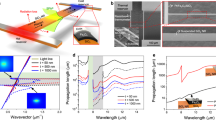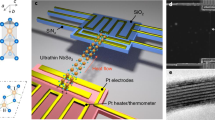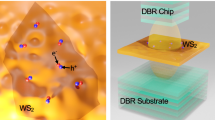Abstract
Surface waves can lead to intriguing transport phenomena. In particular, surface phonon polaritons (SPhPs), which result from coupling between infrared light and optical phonons, have been predicted to contribute to heat conduction along polar thin films and nanowires1. However, experimental efforts so far suggest only very limited SPhP contributions2,3,4,5. Through systematic measurements of thermal transport along the same 3C-SiC nanowires with and without a gold coating on the end(s) that serves to launch SPhPs, here we show that thermally excited SPhPs can substantially enhance the thermal conductivity of the uncoated portion of these wires. The extracted pre-decay SPhP thermal conductance is more than two orders of magnitude higher than the Landauer limit predicted on the basis of equilibrium Bose–Einstein distributions. We attribute the notable SPhP conductance to the efficient launching of non-equilibrium SPhPs from the gold-coated portion into the uncoated SiC nanowires, which is strongly supported by the observation that the SPhP-mediated thermal conductivity is proportional to the length of the gold coating(s). The reported discoveries open the door for modulating energy transport in solids by introducing SPhPs, which can effectively counteract the classical size effect in many technologically important films and improve the design of solid-state devices.
This is a preview of subscription content, access via your institution
Access options
Access Nature and 54 other Nature Portfolio journals
Get Nature+, our best-value online-access subscription
$29.99 / 30 days
cancel any time
Subscribe to this journal
Receive 51 print issues and online access
$199.00 per year
only $3.90 per issue
Buy this article
- Purchase on Springer Link
- Instant access to full article PDF
Prices may be subject to local taxes which are calculated during checkout




Similar content being viewed by others
Data availability
Source data for the main figures are provided with this paper. Source data are provided with this paper.
References
Chen, D., Narayanaswamy, A. & Chen, G. Surface phonon-polariton mediated thermal conductivity enhancement of amorphous thin films. Phys. Rev. B 72, 155435 (2005).
Tranchant, L. et al. Two-dimensional phonon polariton heat transport. Nano Lett. 19, 6924–6930 (2019).
Shin, S., Elzouka, M., Prasher, R. & Chen, R. Far-field coherent thermal emission from polaritonic resonance in individual anisotropic nanoribbons. Nat. Commun. 10, 1377 (2019).
Wu, Y. et al. Enhanced thermal conduction by surface phonon-polaritons. Sci. Adv. 6, eabb4461 (2020).
Wu, Y. et al. Observation of heat transport mediated by the propagation distance of surface phonon-polaritons over hundreds of micrometers. Appl. Phys. Lett. 121, 112203 (2022).
Ziman, J. M. Electrons and Phonons: The Theory of Transport Phenomena in Solids (Oxford Univ. Press, 2001).
Qian, X., Zhou, J. & Chen, G. Phonon-engineered extreme thermal conductivity materials. Nat. Mater. 20, 1188–1202 (2021).
Onose, Y. et al. Observation of the magnon Hall effect. Science 329, 297–299 (2010).
Chen, X. et al. Synthesis and magnon thermal transport properties of spin ladder Sr14Cu24O41 microstructures. Adv. Funct. Mater. 30, 2001637 (2020).
Czajka, P. et al. Planar thermal Hall effect of topological bosons in the Kitaev magnet α-RuCl3. Nat. Mater. 22, 36–41 (2023).
Carminati, R. & Greffet, J. Near-field effects in spatial coherence of thermal sources. Phys. Rev. Lett. 82, 1660 (1999).
Mulet, J., Joulain, K. & Carminati, R. Nanoscale radiative heat transfer between a small particle and a plane surface. Appl. Phys. Lett. 78, 2931–2933 (2001).
Shen, S., Narayanaswamy, A. & Chen, G. Surface phonon polaritons mediated energy transfer between nanoscale gaps. Nano Lett. 9, 2909–2913 (2009).
Kim, K. et al. Radiative heat transfer in the extreme near field. Nature 528, 387–391 (2015).
St-Gelais, R., Zhu, L., Fan, S. & Lipson, M. Near-field radiative heat transfer between parallel structures in the deep subwavelength regime. Nat. Nanotechnol. 11, 515–519 (2016).
Ordonez-Miranda, J. et al. Anomalous thermal conductivity by surface phonon-polaritons of polar nano thin films due to their asymmetric surrounding media. J. Appl. Phys. 113, 084311 (2013).
Ordonez-Miranda, J. et al. Quantized thermal conductance of nanowires at room temperature due to Zenneck surface-phonon polaritons. Phys. Rev. Lett. 112, 055901 (2014).
Ordonez-Miranda, J. et al. Thermal energy transport in a surface phonon-polariton crystal. Phys. Rev. B 93, 035428 (2016).
Yun, K. H., Lee, B. J. & Lee, S. H. Modeling effective thermal conductivity enhanced by surface waves using the Boltzmann transport equation. Sci. Rep. 12, 15477 (2022).
Shi, L. et al. Measuring thermal and thermoelectric properties of one-dimensional nanostructures using a microfabricated device. J. Heat Transf. 125, 881–888 (2003).
Wingert, M. C., Chen, Z., Kwon, S., Xiang, J. & Chen, R. Ultra-sensitive thermal conductance measurement of one-dimensional nanostructures enhanced by differential bridge. Rev. Sci. Instrum. 83, 024901 (2012).
Yang, L. et al. Thermal conductivity of individual silicon nanoribbons. Nanoscale 8, 17895–17901 (2016).
Yang, L. et al. Observation of superdiffusive phonon transport in aligned atomic chains. Nat. Nanotechnol. 16, 764–768 (2021).
Zhao, Y. et al. Electrical and thermal transport through silver nanowires and their contacts: effects of elastic stiffening. Nano Lett. 20, 7389–7396 (2020).
Yang, J. et al. Measurement of the intrinsic thermal conductivity of a multiwalled carbon nanotube and its contact thermal resistance with the substrate. Small 7, 2334–2340 (2011).
Dai, S. et al. Efficiency of launching highly confined polaritons by infrared light incident on a hyperbolic material. Nano Lett. 17, 5285–5290 (2017).
Chen, M. et al. Configurable phonon polaritons in twisted α-MoO3. Nat. Mater. 19, 1307–1311 (2020).
Novotny, L. & Hecht, B. Principles of Nano-Optics 2nd edn (Cambridge Univ. Press, 2012).
Hu, G., Shen, J., Qiu, C., Alù, A. & Dai, S. Phonon polaritons and hyperbolic response in van der Waals materials. Adv. Opt. Mater. 8, 1901393 (2020).
Hillenbrand, R., Taubner, T. & Keilmann, F. Phonon-enhanced light–matter interaction at the nanometre scale. Nature 418, 159–162 (2002).
Schuller, J. A., Taubner, T. & Brongersma, M. L. Optical antenna thermal emitters. Nat. Photonics 3, 658–661 (2009).
Huber, A. J., Deutsch, B., Novotny, L. & Hillenbrand, R. Focusing of surface phonon polaritons. Appl. Phys. Lett. 92, 203104 (2008).
Low, T. et al. Polaritons in layered two-dimensional materials. Nat. Mater. 16, 182–194 (2017).
Greffet, J. J. et al. Coherent emission of light by thermal sources. Nature 416, 61–64 (2002).
Eaton, S. W., Fu, A., Wong, A. B., Ning, C. Z. & Yang, P. Semiconductor nanowire lasers. Nat. Rev. Mater. 1, 16028 (2016).
Domoto, G. A., Boehm, R. F. & Tien, C. L. Experimental investigation of radiative transfer between metallic surfaces at cryogenic temperatures. J. Heat Transf. 3, 412–416 (1970).
Thompson, D. et al. Hundred-fold enhancement in far-field radiative heat transfer over the blackbody limit. Nature 561, 216–221 (2018).
Zhang, Q. et al. Thermal transport in quasi-1D van der Waals crystal Ta2Pd3Se8 nanowires: size and length dependence. ACS Nano 12, 2634–2642 (2018).
Teitsworth, T. S. et al. Water splitting with silicon p–i–n superlattices suspended in solution. Nature 614, 270–274 (2023).
Blöchl, P. E. Projector augmented-wave method. Phys. Rev. B 50, 17953 (1994).
Kresse, G. & Furthmüller, J. Efficiency of ab-initio total energy calculations for metals and semiconductors using a plane-wave basis set. Comput. Mater. Sci. 6, 15–50 (1996).
Kresse, G. & Furthmüller, J. Efficient iterative schemes for ab initio total-energy calculations using a plane-wave basis set. Phys. Rev. B 54, 11169 (1996).
Kresse, G. & Joubert, D. From ultrasoft pseudopotentials to the projector augmented-wave method. Phys. Rev. B 59, 1758 (1999).
Perdew, J. P., Burke, K. & Ernzerhof, M. Generalized gradient approximation made simple. Phys. Rev. Lett. 77, 3865 (1996).
Togo, A. & Tanaka, I. First principles phonon calculations in materials science. Scr. Mater. 108, 1–5 (2015).
Li, W., Carrete, J., Katcho, N. A. & Mingo, N. ShengBTE: a solver of the Boltzmann transport equation for phonons. Comput. Phys. Commun. 185, 1747–1758 (2014).
Serrano, J., Strempfer, J. & Cardona, M. Determination of the phonon dispersion of zinc blende (3C) silicon carbide by inelastic x-ray scattering. Appl. Phys. Lett. 80, 4360–4362 (2002).
Widulle, F., Ruf, T., Buresch, O., Debernardi, A. & Cardona, M. Raman study of isotope effects and phonon eigenvectors in SiC. Appl. Phys. Lett. 82, 3089 (1999).
Fermi, E. Nuclear Physics: A Course Given by Enrico Fermi at the University of Chicago (Univ. Chicago Press, 1950).
Omini, M. & Sparavigna, A. Beyond the isotropic-model approximation in the theory of thermal conductivity. Phys. Rev. B 53, 9064 (1996).
Broido, D., Ward, A. & Mingo, N. Lattice thermal conductivity of silicon from empirical interatomic potentials. Phys. Rev. B 72, 014308 (2005).
Ashley, J. C. & Emerson, L. C. Dispersion relations for non-radiative surface plasmons on cylinders. Surf. Sci. 41, 615–618 (1974).
Li, Y., Qi, R., Shi, R., Li, N. & Gao, P. Manipulation of surface phonon polaritons in SiC nanorods. Sci. Bull. 65, 820–826 (2020).
Sun, S., Chen, H., Zheng, W. & Guo, G. Dispersion relation, propagation length and mode conversion of surface plasmon polaritons in silver double-nanowire systems. Opt. Express 21, 14591–14605 (2013).
Englman, R. & Ruppin, R. Optical lattice vibrations in finite ionic crystals: III. J. Phys. C Solid State Phys. 1, 1515 (1968).
Palik, E. D. Handbook of Optical Constants of Solids (Academic, 1998).
Murphy, P. & Moore, J. Coherent phonon scattering effects on thermal transport in thin semiconductor nanowires. Phys. Rev. B 76, 155313 (2007).
Acknowledgements
We thank A. Majumdar, G. Chen, P. Reddy, G. Walker, J. Valentine, S. Shen, L. Yang and P. Gao for helpful discussions. Z.P. and D.L. thank the financial support from the National Science Foundation (award nos. 1903645 and 2114278). G.L. acknowledges support from the Army Research Office under grants W911NF-21-1-0119 and W911NF-22-P-0029. J.D.C. would like to acknowledge support from the Office of Naval Research under grant N00014-22-1-2035. Density-functional-theory-based calculations (L.L., X.L. and R.J.) were supported by the U.S. Department of Energy, Office of Science, Basic Energy Sciences, Materials Sciences and Engineering Division. Computational resources were provided by the Compute and Data Environment for Science (CADES) at Oak Ridge National Laboratory, which is supported by the Office of Science of the U.S. Department of Energy under contract no. DE-AC05-00OR22725, and by the National Energy Research Scientific Computing Center (NERSC), which is supported by the Office of Science of the U.S. Department of Energy under contract no. DE-AC02-05CH11231.
Author information
Authors and Affiliations
Contributions
D.L. and Z.P. designed the thermal experiment and analysed the data. Z.P. conducted the thermal measurements and SEM characterizations. G.L. and J.D.C. performed s-SNOM measurements and CST modelling, with assistance from M.L. X.L., R.J. and L.L. performed first-principles calculations on optical phonon scattering and equilibrium thermal conductance. Z.P. and J.R.M. conducted the TEM examination. D.L., J.D.C. and L.L. directed the thermal experiments, optical experiments and theoretical calculations, respectively. D.L. and Z.P. drafted the manuscript, with input from all authors. All authors participated in the writing and discussions.
Corresponding author
Ethics declarations
Competing interests
The authors declare no competing interests.
Peer review
Peer review information
Nature thanks the anonymous reviewers for their contribution to the peer review of this work. Peer reviewer reports are available.
Additional information
Publisher’s note Springer Nature remains neutral with regard to jurisdictional claims in published maps and institutional affiliations.
Extended data figures and tables
Extended Data Fig. 1 Theoretical calculations.
Calculated SiC SPhP dispersions (a,b) and attenuations for different radii and branches (c,d). Note that all higher-order modes (n > 1) overlap with the first-order mode (n = 1) in the upper two panels, showing the SPhP dispersion. The sloped dashed and solid lines indicate the SiC and the free-space light lines in the upper two panels, respectively.
Extended Data Fig. 2 Further experimental data.
a, The overlapping thermal conductivity of an uncoated SiC nanowire measured with two different suspended lengths, indicating negligible contact thermal resistance. b, Extracted SPhP thermal conductivity (brown symbols) and percentage enhancement (blue symbols). Inset shows the sample bridging the two membranes, with the Au-coated segment placed on one membrane. c, An SEM micrograph of the sample after most of the suspended bare SiC nanowire was cut off by a sharp probe. d, Thermal conductance between membranes for the device with the Au-coated segment as shown in c (brown symbols) and a blank device of identical dimension (black symbols).
Supplementary information
Supplementary Information
This file contains further theoretical simulation information, sample preparation details for thermal measurements, uncertainty analysis, thermal data summary, further optical results, Supplementary Figs. 1–22, Supplementary Tables 1 and 2 and Supplementary References.
Source Code 1
Original MATLAB code used to solve for the dispersions and attenuations of bulk in Extended Data Fig. 1
Source Code 2
Original MATLAB code used to solve for the dispersions and attenuations of SPhPs in Extended Data Fig. 1
Rights and permissions
Springer Nature or its licensor (e.g. a society or other partner) holds exclusive rights to this article under a publishing agreement with the author(s) or other rightsholder(s); author self-archiving of the accepted manuscript version of this article is solely governed by the terms of such publishing agreement and applicable law.
About this article
Cite this article
Pan, Z., Lu, G., Li, X. et al. Remarkable heat conduction mediated by non-equilibrium phonon polaritons. Nature 623, 307–312 (2023). https://doi.org/10.1038/s41586-023-06598-0
Received:
Accepted:
Published:
Issue Date:
DOI: https://doi.org/10.1038/s41586-023-06598-0
This article is cited by
-
Planar hyperbolic polaritons in 2D van der Waals materials
Nature Communications (2024)
Comments
By submitting a comment you agree to abide by our Terms and Community Guidelines. If you find something abusive or that does not comply with our terms or guidelines please flag it as inappropriate.



